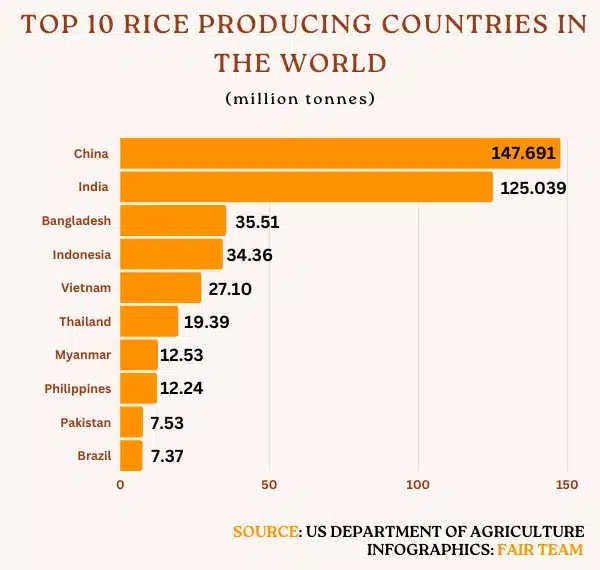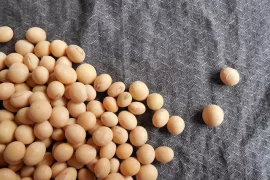Rice is a staple food for more than half of the world’s population, making it one of the most essential and widely cultivated crops globally. With the increasing demand for food security and sustainable agriculture practices, the rice-producing countries play a crucial role in ensuring adequate supply for their populations and global markets. In this article, we will explore the top 10 rice-producing countries and highlight their significant contributions to the world’s rice production.
List of the top 10 rice producing countries in the world
The top 10 rice producing countries in the world are China, India, Bangladesh, Indonesia, Vietnam, Thailand, Myanmar, Philippines, Pakistan Brazil. It is also interesting to note that the top 10 countries produce around 84% of the world’s rice. There are over 50,000 varieties of rice in the world.
China, 147.691 million tonnes, the top rice producing country
China leads as the top rice-producing nation, meeting domestic demand and exporting globally. Vast agricultural landscapes and advanced farming techniques contribute to its unrivaled position. The country achieves an impressive annual output of 147.691 million tonnes (5-year Average; 2018/19 – 2022/23), cultivated across 29.87 million hectares (5-year Average; 2018/19 – 2022/23). In the 2023-24 season, China’s rice production is projected to reach 149 million tonnes, solidifying its agricultural prowess.
India, 125.039 million tonnes
India closely trails China in rice production and boasts a diverse array of rice varieties cultivated across various regions. With fertile lands, favorable climate, and traditional farming practices, India holds a significant position in global rice exports. Achieving an annual output of 125.039 million tonnes (5-year Average; 2018/19 – 2022/23) across 45.513 million hectares (5-year Average; 2018/19 – 2022/23), India’s agricultural might is evident. The projected rice production of 134 million tonnes for the 2023-24 season further cements India’s prowess in the agricultural sector.
Bangladesh, 35.512 million tonne
Bangladesh heavily relies on rice as a staple food, and rice cultivation is a vital component of its agricultural economy. The country’s fertile deltas and continuous efforts to modernize farming techniques have contributed to its significant rice production. Producing an annual output of 35.512 million tonnes (5-year Average; 2018/19 – 2022/23) across 11.66 million hectares (5-year Average; 2018/19 – 2022/23), Bangladesh showcases its agricultural strength. The projected rice production of 37 million tonnes for the 2023-24 season solidifies Bangladesh’s position as an agricultural powerhouse.
Indonesia, 34.36 million tonnes
Indonesia benefits from its warm and humid climate, providing an ideal setting for rice cultivation. With a robust agricultural sector and government backing, Indonesia consistently ranks among the top global rice producers. Producing an annual output of 34.36 million tonnes (5-year Average; 2018/19 – 2022/23) across 11.53 million hectares (5-year Average; 2018/19 – 2022/23), Indonesia showcases its agricultural strength. The projected rice production of 34.45 million tonnes for the 2023-24 season also solidifies Indonesia’s position as an agricultural powerhouse.
Vietnam, 27.10 million tonnes
Vietnam holds a prominent position in the global rice market. It is famous for its high-quality rice varieties. The country’s focus on agricultural innovation and efficient irrigation systems has positioned it as a significant rice exporter. With an annual output of 27.10 million tonnes (5-year Average; 2018/19 – 2022/23) cultivated across 7.30 million hectares (5-year Average; 2018/19 – 2022/23), Vietnam demonstrates its agricultural prowess. The projected rice production of 27 million tonnes for the 2023-24 season further cements Vietnam’s status as an agricultural powerhouse.
Thailand, 19.39 million tonnes
Thailand is celebrated for its aromatic and premium rice varieties, highly sought after in international markets. The country’s well-established rice sector and government support contribute significantly to global rice production. With an annual output of 19.39 million tonnes (5-year Average; 2018/19 – 2022/23) cultivated across 10.55 million hectares (5-year Average; 2018/19 – 2022/23), Thailand showcases its agricultural strength. Moreover, its projected rice production for the 2023-24 season is 19.70 million tonnes.
Myanmar, 12.53 million tonnes
Myanmar stands as a prominent rice-producing nation, benefiting from its fertile lands and favorable climate. The country’s focused efforts to expand rice cultivation and enhance post-harvest infrastructure have led to a notable increase in rice production. With an annual output of 12.53 million tonnes (5-year Average; 2018/19 – 2022/23) cultivated across 6.93 million hectares (5-year Average; 2018/19 – 2022/23), Myanmar showcases its agricultural strength. The projected rice production of 12.50 million tonnes for the 2023-24 season further solidifies Myanmar’s position as an agricultural powerhouse.
Philippines, 12.243 million tonnes
Rice stands as a staple food in the Philippines. The country has consistently maintained a significant level of rice production to meet its domestic demands. Government initiatives and agricultural reforms continuously work towards enhancing rice productivity in the nation. With an annual output of 12.243 million tonnes (5-year Average; 2018/19 – 2022/23) cultivated across 4.75 million hectares (5-year Average; 2018/19 – 2022/23), the Philippines showcases its agricultural strength. The projected rice production of 12.60 million tonnes for the 2023-24 season further strengthens the Philippines’ position as an agricultural powerhouse.
Pakistan, 7.53 million tonnes
Pakistan ranks among the major rice-producing nations globally, and rice holds significance as one of its staple foods. The country’s diverse agro-climatic conditions, particularly in the provinces of Punjab and Sindh, provide conducive environments for rice cultivation. With an annual output of 7.53 million tonnes (5-year Average; 2018/19 – 2022/23) across 3.14 million hectares (5-year Average; 2018/19 – 2022/23), Pakistan exemplifies its strength in the rice sector. Additionally, the country’s projected rice production for the 2023-24 season is 9 million tonnes.
Brazil, 7.37 million tonnes, 10th top rice producing country
Brazil’s expansive agricultural lands and favorable weather conditions position it as a significant player in the global rice market. While the country primarily focuses on other crops, its rice production remains noteworthy. With an annual output of 7.37 million tonnes (5-year Average; 2018/19 – 2022/23) cultivated across 1.63 million hectares (5-year Average; 2018/19 – 2022/23), Brazil exemplifies its strength in the rice sector. Additionally, its projected rice production for the 2023-24 season is 6.8 million tonnes.
Summary of the top 10 rice producing countries in the world
In conclusion, rice is undoubtedly a vital crop for sustaining the world’s growing population. These top 10 rice-producing countries play a crucial role in ensuring global food security. Their efforts in agricultural innovation, sustainable farming practices, and consistent productivity contribute to the availability of this essential staple food in various regions of the world. As the global demand for rice continues to increase, these countries remain at the forefront of rice production. They are crucial in shaping the future of global food systems.








